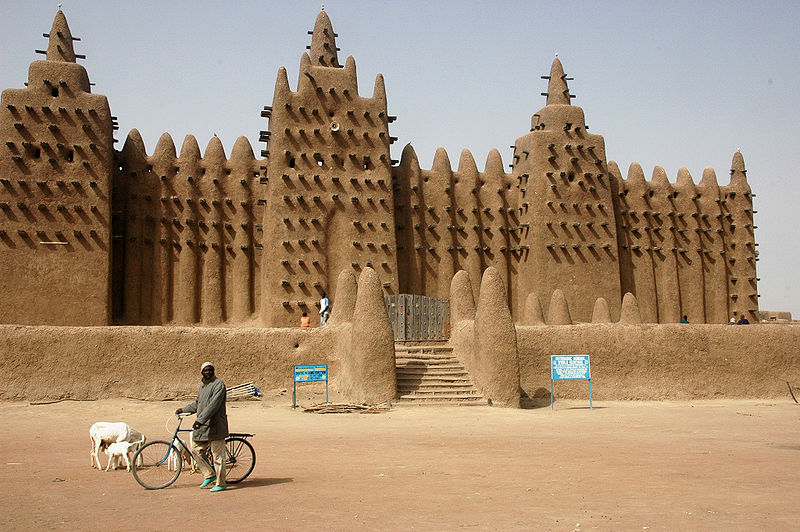Hello ladies and gents this is the viking telling you that today we are talking about

Great Mosque of Djenné

The Great Mosque of Djenné is a large banco or adobe building that is considered by many architects to be one of the greatest achievements of the Sudano-Sahelian architectural style. The mosque is located in the city of Djenné, Mali, on the flood plain of the Bani River. The first mosque on the site was built around the 13th century, but the current structure dates from 1907. As well as being the centre of the community of Djenné, it is one of the most famous landmarks in Africa. Along with the "Old Towns of Djenné" it was designated a World Heritage Site by UNESCO in 1988.
The walls of the Great Mosque are made of sun-baked earth bricks (called ferey), and sand and earth based mortar, and are coated with a plaster which gives the building its smooth, sculpted look. The walls of the building are decorated with bundles of rodier palm (Borassus aethiopum) sticks, called toron, that project about 60 cm (2.0 ft) from the surface. The toron also serve as readymade scaffolding for the annual repairs. Ceramic half-pipes also extend from the roofline and direct rain water from the roof away from the walls.
The mosque is built on a platform measuring about 75 m × 75 m (246 ft × 246 ft) that is raised by 3 metres (9.8 feet) above the level of the marketplace. The platform prevents damage to the mosque when the Bani River floods. It is accessed by six sets of stairs, each decorated with pinnacles. The main entrance is on the northern side of the building. The outer walls of the Great Mosque are not precisely orthogonal to one another so that the plan of the building has a noticeable trapezoidal outline.
The prayer wall or qibla of the Great Mosque faces east towards Mecca and overlooks the city marketplace. The qibla is dominated by three large, box-like towers or minarets jutting out from the main wall. The central tower is around 16 meters in height. The cone shaped spires or pinnacles at the top of each minaret are topped with ostrich eggs. The eastern wall is about a meter (3 ft) in thickness and is strengthened on the exterior by eighteen pilaster like buttresses, each of which is topped by a pinnacle. The corners are formed by rectangular shaped buttresses decorated with toron and topped by pinnacles.
The prayer hall, measuring about 26 by 50 meters (85 by 164 ft), occupies the eastern half of the mosque behind the qibla wall. The mud-covered, rodier-palm roof is supported by nine interior walls running north–south which are pierced by pointed arches that reach up almost to the roof. This design creates a forest of ninety massive rectangular pillars that span the interior prayer hall and severely reduce the field of view. The small, irregularly-positioned windows on the north and south walls allow little natural light to reach the interior of the hall. The floor is composed of sandy earth.
In the prayer hall, each of the three towers in the qibla wall has a niche or mihrab. The imam conducts the prayers from the mihrab in the larger central tower. A narrow opening in the ceiling of the central mihrab connects with a small room situated above roof level in the tower. In earlier times, a crier would repeat the words of the imam to people in the town. To the right of the mihrab in the central tower is a second niche, the pulpit or minbar, from which the imam preaches his Friday sermon.
The towers in the qibla wall do not contain stairs linking the prayer hall with the roof. Instead there are two square towers housing stairs leading to the roof. One set of stairs is located at the south western corner of the prayer hall while the other set, situated near the main entrance on the northern side, is only accessible from the exterior of the mosque. Small vents in the roof are topped with removable inverted kiln-fired bowls, which when removed allow hot air to rise out of the building and so ventilate the interior.
The interior courtyard to the west of the prayer hall, measuring 20 m × 46 m (66 ft × 151 ft), is surrounded on three sides by galleries. The walls of the galleries facing the courtyard are punctuated by arched openings. The western gallery is reserved for use by women.
Though it benefits from regular maintenance, since the facade's construction in 1907 only small changes have been made to the design. Rather than a single central niche, the mirhab tower originally had a pair of large recesses echoing the form of the entrance arches in the north wall. The mosque also had many fewer toron with none on the corner buttresses. It is evident from published photographs that two additional rows of toron were added to the walls in the early 1990s.
And as always have a chilled day from the Viking.
Comments
Post a Comment